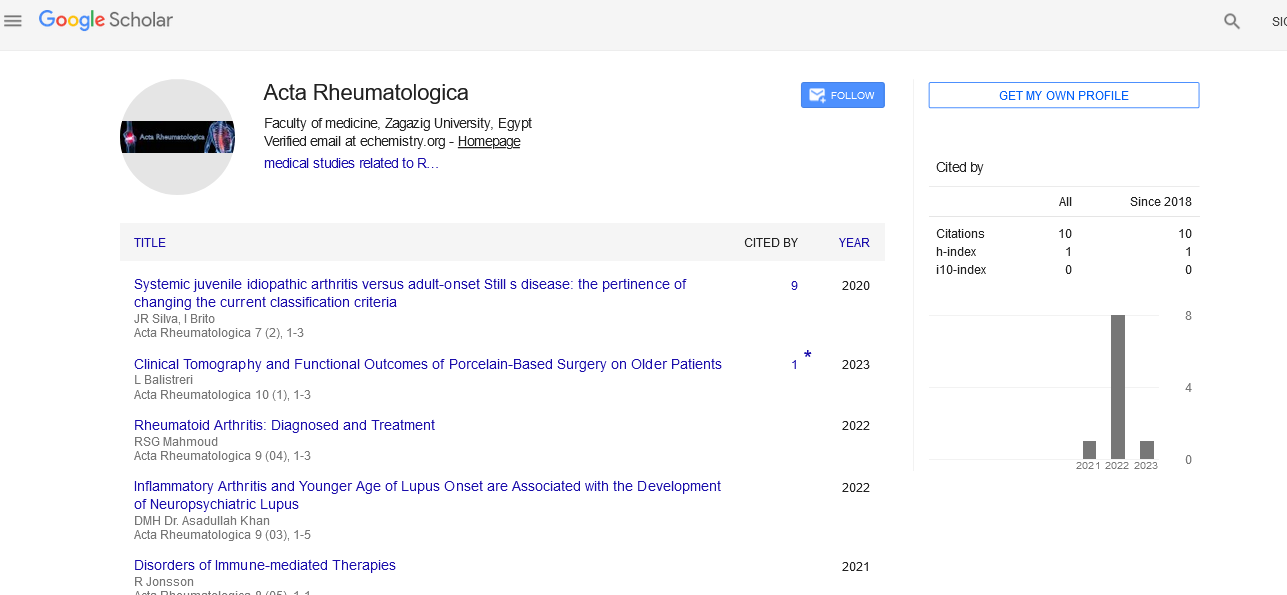Perspective - (2024) Volume 11, Issue 3
Bridging the Gaps: Exploring Connective Tissue Diseases and Their Impact on Health
Sibel Zehra Aydin*
Department of Rheumatology, NOSM University, Thunder Bay, Canada
*Correspondence:
Sibel Zehra Aydin, Department of Rheumatology, NOSM University, Thunder Bay,
Canada,
Email:
Received: 11-May-2024, Manuscript No. IPAR-24-14800;
Editor assigned: 14-May-2024, Pre QC No. IPAR-24-14800 (PQ);
Reviewed: 29-May-2024, QC No. IPAR-24-14800;
Revised: 06-Jun-2024, Manuscript No. IPAR-24-14800 (R);
Published:
14-Jun-2024
Introduction
Connective Tissue Diseases (CTDs) encompass a diverse
spectrum of autoimmune disorders characterized by immune-mediated
inflammation and dysfunction of connective tissues
throughout the body. From the systemic manifestations of
Systemic Lupus Erythematosus (SLE) to the localized pathology
of scleroderma, these conditions pose diagnostic and
therapeutic challenges, impacting multiple organ systems and
profoundly affecting patients' quality of life. In this article, we
embark on a comprehensive exploration of connective tissue
diseases, unraveling their underlying mechanisms, clinical
manifestations, diagnostic strategies, treatment modalities, and
avenues for ongoing research and innovation.
Connective tissues serve as the structural framework of the
body, providing support, integrity, and elasticity to various
organs, including skin, joints, blood vessels, and internal organs.
Comprising cells, fibers, and ground substance, connective
tissues exhibit remarkable diversity and plasticity, adapting to
physiological demands and responding to pathological insults.
Collagen, elastin, and proteoglycans are among the key
constituents of connective tissues, conferring tensile strength,
flexibility, and hydration to tissues, while fibroblasts, adipocytes,
and immune cells orchestrate tissue homeostasis and repair
processes.
Description
Systemic lupus erythematosus: Unraveling the
complexities of multisystem autoimmunity
Systemic Lupus Erythematosus (SLE) stands as a prototypical
autoimmune connective tissue disease, characterized by the
production of autoantibodies targeting nuclear antigens,
aberrant immune activation, and widespread inflammation
affecting multiple organ systems. Clinical manifestations of SLE
are highly variable, encompassing skin rashes, arthritis, nephritis,
hematologic abnormalities, and neurological manifestations,
among others. Diagnostic criteria for SLE encompass clinical,
serological, and immunological parameters, with antinuclear
antibodies and specific autoantibodies serving as hallmark
serological markers. Management of SLE entails a
multidisciplinary approach, integrating immunosuppressive
agents, biologic therapies, and supportive care tailored to
disease severity and organ involvement.
Rheumatoid arthritis: Joint-centric in lammation in a
systemic context
While primarily considered a joint-centric disorder,
Rheumatoid Arthritis (RA) exemplifies the systemic nature of
connective tissue diseases, with extra-articular manifestations
impacting various organs and tissues. Autoantibodies targeting
citrullinated proteins, such as Anti-Cyclic Citrullinated Peptide
antibodies (anti-CCP), play a central role in RA pathogenesis,
driving synovial inflammation, cartilage destruction, and bone
erosion. Early diagnosis and aggressive treatment strategies are
pivotal in mitigating disease progression, preserving joint
function, and preventing irreversible damage. Biologic agents
targeting pro-inflammatory cytokines, such as Tumor Necrosis
Factor-Alpha (TNF-α) and Interleukin-6 (IL-6), have revolutionized
RA management, offering unprecedented efficacy in controlling
inflammation and improving clinical outcomes.
Scleroderma: Unveiling the pathophysiology of
fibrosis and vasculopathy
Scleroderma, also known as Systemic Sclerosis (SSc), represents
a heterogeneous connective tissue disease characterized by
fibrosis, vasculopathy, and immune dysregulation affecting the
skin, lungs, gastrointestinal tract, and other organs. Endothelial
dysfunction, aberrant fibroblast activation, and dysregulated
immune responses contribute to the pathogenesis of SSc,
culminating in tissue fibrosis, microvascular injury, and organ
dysfunction. Treatment of SSc focuses on symptom management,
organ-specific complications, and targeted immunomodulatory
therapies aimed at modulating fibrosis and vasculopathy.
Emerging therapeutic str ategies and future directions
The landscape of connective tissue disease therapeutics is
witnessing rapid evolution, driven by advances in immunology,
molecular biology, and precision medicine. Biologic agents
targeting specific immune pathways, such as B cells, cytokines,
and cellular receptors, offer promising alternatives for refractory
disease cases resistant to conventional treatments. Moreover,
regenerative approaches, including stem cell therapy and tissue
engineering, hold potential for restoring tissue integrity and
function, heralding a new era of personalized and regenerative
medicine in the management of connective tissue diseases.
Conclusion
Connective tissue diseases represent a complex and
challenging group of disorders with systemic manifestations and
multifaceted pathophysiology. By unraveling the molecular
underpinnings of connective tissue diseases, embracing
multidisciplinary approaches to patient care, and fostering
innovation and collaboration, we can strive towards improved
outcomes and enhanced quality outcomes and enhanced quality
of life for individuals grappling with these debilitating conditions.
As we navigate the intricate terrain of connective tissue diseases,
armed with knowledge, empathy, and scientific ingenuity, we
forge a path towards a future where connective tissues are
preserved, and individuals thrive in health and resilience.
Citation: Aydin SZ (2024) Bridging the Gaps: Exploring Connective Tissue Diseases and their Impact on Health. Acta Rheuma Vol:11 No:3





